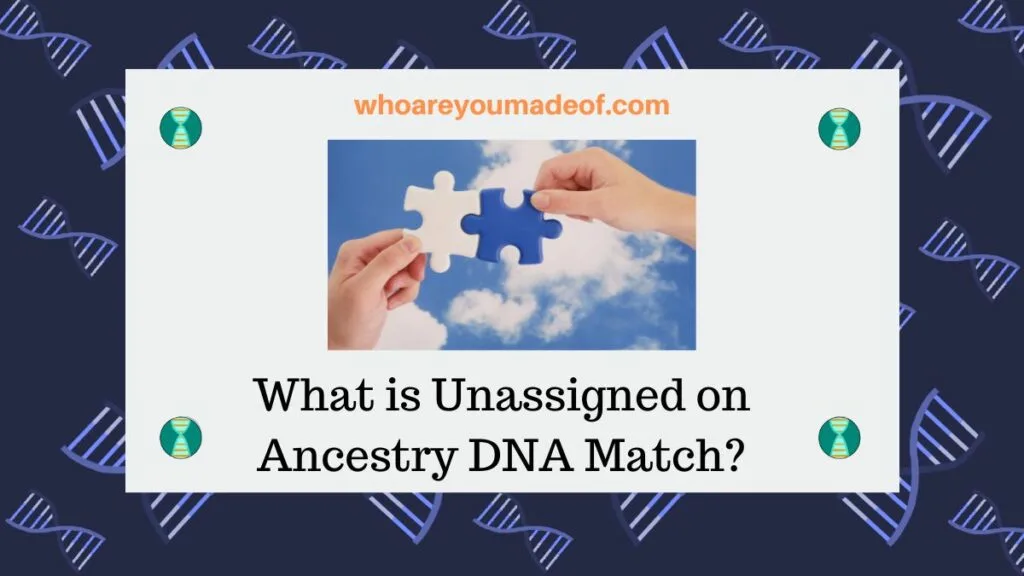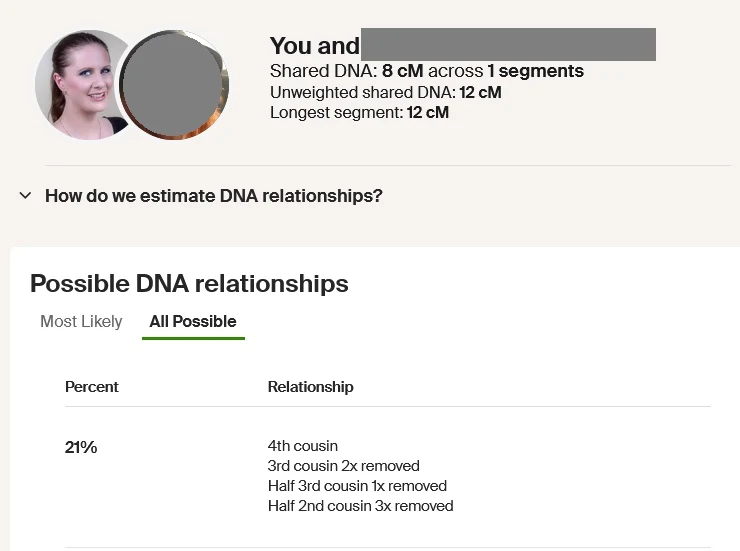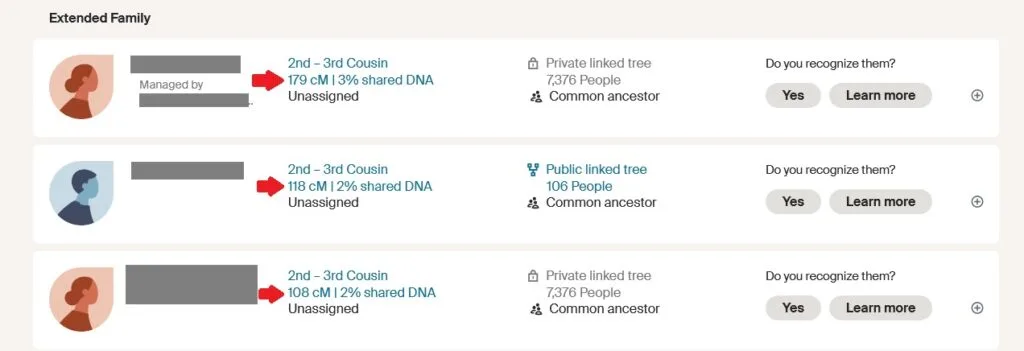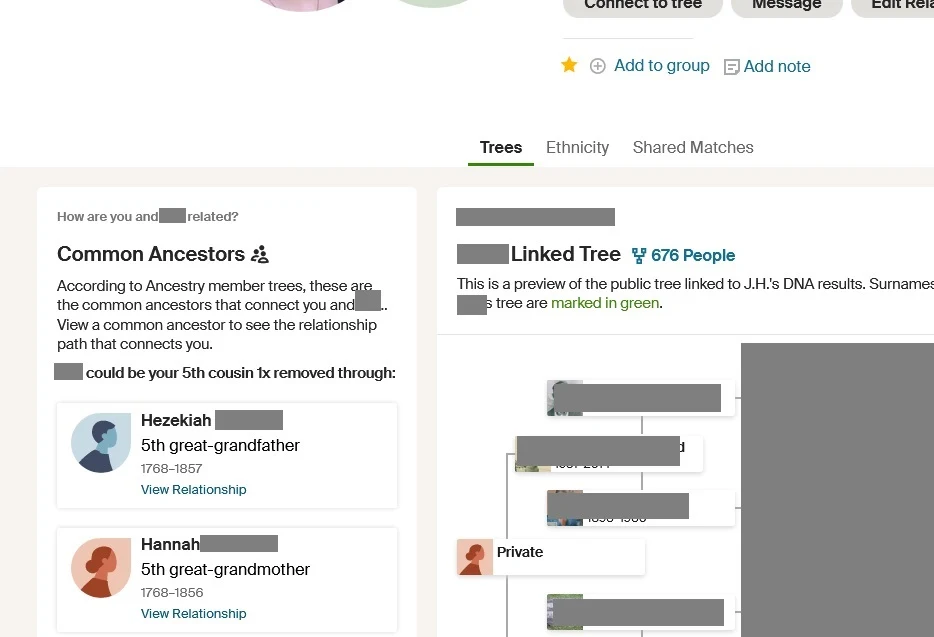If you look at your Ancestry DNA match list, you probably see some matches are labeled "Unassigned". In this post, find out exactly what this means.

The Ancestry match list is my favorite element of DNA results. We can learn so much by exploring our DNA matches and trying to identify which ancestor we share in common.
We can build our family trees and connect with new relatives right from our match list. However, sometimes exploring the DNA matches can be overwhelming, especially when we can't figure out on which side of the family the match is related.
This is where "Unassigned" DNA matches come into play.
I should mention that the "Unassigned" on the DNA match list is not the same as the "unassigned" that you might see on the Chromosome Painter feature, which is part of the ethnicity estimate.
What does Unassigned mean on a DNA match?
Unassigned DNA matches on Ancestry are matches that cannot be assigned to Parent 1 or Parent 2 on your DNA match list. This means that Ancestry's software was not able to determine whether this match is a maternal or paternal DNA match.
Ancestry is able to assign many of our DNA matches to Parent 1 or Parent 2, or maternal and paternal, if you have edited those labels, by examining our shared DNA. They do not use our family trees to calculate this information.
This feature uses the Ancestry DNA Matches By Parent technology, which can help us figure out whether our matches are on our maternal or paternal side of our family trees.
When a DNA match is Unassigned, it simply means that the computer doesn't have enough information to tell us which side of the family the match belongs to. Over time, we might see some of our Unassigned matches assigned to Parent 1 or Parent 2, but not always.
In the image below, you will find an example of an Unassigned DNA match on Ancestry. This is one of my distant cousin matches, as Ancestry estimates we likely 5th-8th cousins.

While it is possible that we are more closely related than 5th cousin, it is more likely that Ancestry is correct in its estimate. DNA matches sharing only a single 8 centimorgan DNA segment are not closely related, which means that we would need to look pretty far back in our family trees to identify our common ancestor.
Are Unassigned DNA matches false?
Since the Unassigned match I showed in the example above shares a very small amount of DNA with me, I must also consider the possibility that we are not really related. DNA matches sharing a single, small DNA segment are more likely to be false DNA matches than those people who share more DNA with us.
However, just because a DNA match is Unassigned does not mean that we are unrelated. Being labeled as Unassigned does not make the match less likely to be related.
Will a match move from Unassigned to Parent 1 or Parent 2?
As more people take DNA tests with Ancestry and the technology is further refined, we can expect our DNA match list that is grouped By Parent to periodically update. When these updates occur, some of our matches might move from the Unassigned group and be labeled as Parent 1 or Parent 2.
This is one reason why it is important to occasionally check back with your DNA match list to review how it has changed. Plus, we can usually expect to find new DNA matches over time.
To help Ancestry sort our matches by parent, we can ask some of our close and extended family members to take DNA tests. Siblings, aunts, uncles, as well as first and second cousins, are just a few examples of relatives who can take Ancestry DNA tests to help us learn about our shared ancestors, and improve the quality of our DNA match lists.
For example, my husband is going to ask a maternal half-brother and a paternal half-brother to take Ancestry tests. He hopes that this will help the DNA matching algorithm sort his more distant matches into maternal and paternal groups more easily.
What does Pending Update mean?
If you see "Pending Update" on your Unassigned DNA matches, then it is possible that you could see some of these matches labeled with the maternal or paternal (i.e. Parent 1 and Parent 2) label after the next DNA match update.
Essentially, this means that you might see the Unassigned DNA match list change over time.
How to figure out how an Unassigned match is related
Fortunately, if you have an Unassigned DNA match, you can still take steps to figure out which side of the family they are on. You might even be able to figure out your relationship and identify your common ancestor.
Check your shared DNA
The first step is to evaluate your relationship by examining your shared DNA. You can find more details about your shared DNA by clicking on your Unassigned DNA match's name, and then clicking on the blue link that states how much DNA you share with your match.
For the example match I am including here, I see that we share 8 centimorgans across one segment, and that the unweighted shared DNA is 12 centimorgans (cMs).

You can also see that there are some relationship possibilities listed on this page. I clicked on the "All Possible" relationships tab, but the default was the "Most Likely" tab, which coincidentally was empty.
In other words, Ancestry is telling me that I am most likely not related to this match. With a little further investigation, I came to the same conclusion.
Not all of our Unassigned matches will be very distant, or unrelated. For example, my top three unassigned DNA matches are known relatives to me and share between 108-179 cMs with me.

If after checking your shared DNA with your match, you feel like you should still keep researching, there is more you can do to figure out how you are connected to your Unassigned match.
See if you have shared DNA matches
From the DNA match profile page, click on the "Shared Matches" tab to see if your DNA match shares other people in common with you on their list. If you have known close or extended relatives in common, you can move forward with the assumption that the Unassigned match is related on the same side of the family as those closer relatives.
If one or both of your parents have taken a test, this is a good time to check to see if you see them as a shared DNA match. This can help you figure out which side of the family your match is on.
Also, if both of your parents have tested but neither one of them shows up as a shared match, this is a quick way to determine that you are not really related to the DNA match. Since we inherit all of our DNA from our parents, if neither parent shares DNA with the match, we can now assume that we share a "coincidentally identical DNA segment" with this person and are not genetically related.
Look at their family tree
Once you have an idea about which side of the tree your match is related on, you should now see if they have a family tree attached to their DNA results. Hopefully, you have attached your tree to your results, too.
This is a good way to look for a surname that you share in common.
Look for a Common Ancestor Hint
If both you and your DNA matches have a family tree attached to your results, Ancestry's algorithm may have already given you a "Common Ancestor Hint". This "hint" uses both DNA and family tree information to tell you who your common ancestor is likely to be.
If you have a Common Ancestor Hint with an Unassigned DNA match, you will see this information on your DNA match profile page. I've shown an example here so you can see for yourself where to look.

Ancestry has determined that this DNA match and I might be 5th cousins once-removed through my 5th great-grandparents. I can decide whether or not I feel this information is correct by looking at their tree, checking my own, and possible even exploring genealogy records to see if I agree that there is a real genealogical relationship.
Conclusion
I hope that this post has helped you understand more about the meaning of "unassigned" on Ancestry, and how you can still determine how these matches are related to you. We are sure to be able to learn as much from our Unassigned matches as we can from matches that have been sorted into the maternal and paternal groups.
If you have any questions about something that you read in this article, or if you would like to share an example of an Unassigned match that you know for sure is related to you, I would love to hear from you in the discussion below.
Thanks for stopping by today!

Ridge N. A. Cantu
Tuesday 18th of November 2025
This is exactly what I needed to read today Your words have given me a new perspective and renewed hope Thank you
Randy
Tuesday 4th of July 2023
I recently had a notification of a match: Shared DNA: 722 cM across 30 segments Unweighted shared DNA: 722 cM Longest segment: 62 cM When I click on "Shared Matches" I get results from both of my parents sides - does this make any sense? I get my fathers half sister as a shared match as well as two of my 1st cousins on my mothers side? this is baffling - help?
Macky
Thursday 8th of June 2023
PENDING UPDATE has been stuck for seven plus months. Yet they raised my subscription rate $40. Ancesholes
Larry(Laurence) Sevitt
Monday 24th of April 2023
I have written to you many times complaining about that I paid for DNA & sent the sample I also paid for family tree & got no response . all I did get was immediate family of which I am very aware I feel that you are just piss takers !!!
Iain M Cooke
Saturday 10th of December 2022
I do not agree that unassigned dna matches means that ancestry have been unable to determine whether they are paternal or maternal, since it started my paternal and maternal numbers have stayed exactly the same and unassigned has increased each and every day. Ancestry are clearly not running the algorithm just adding any new dna matches to unassigned unless of course this is just a coincidence?
Nikki
Friday 16th of December 2022
@Iain M Cooke, you're correct. The paternal/maternal/unassigned categories are only accurate to April 2022. All dna matches added since then go to unassigned, presumably until they do another big update. Wish they would get on with it because I suddenly have 3 half sisters since August. Of course we don't need Ancestry to tell us who the shared parent is between us, but seeing them in the unassigned category, with our 25% shared DNA, while distant relatives are assigned is pretty annoying.